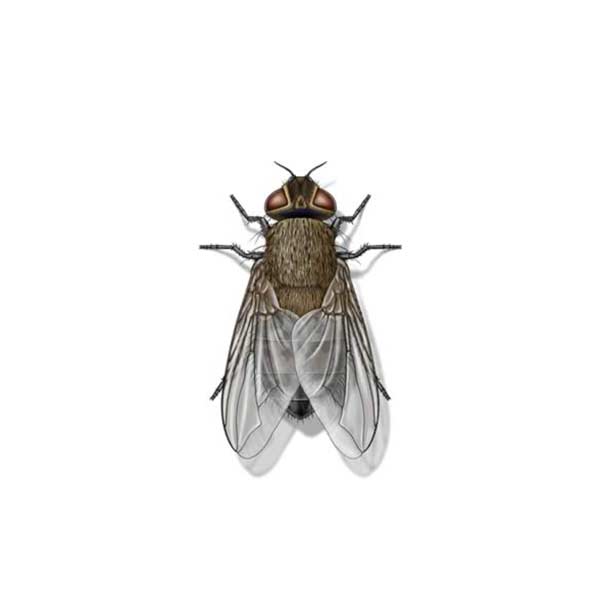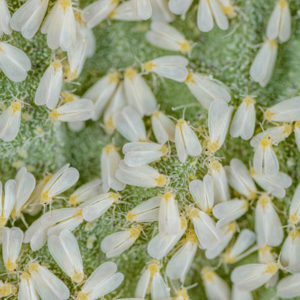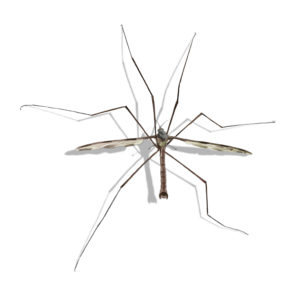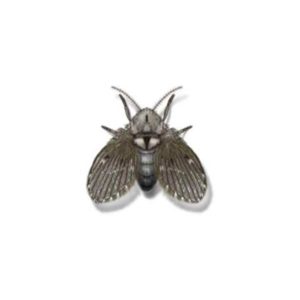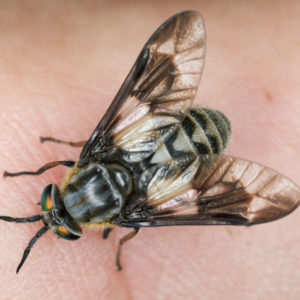Cluster flies are a member of the blowfly family and are widely distributed throughout the United States, except for the states bordering Mexico. These insects enter houses in the fall to hibernate and often gather in secluded and sometimes inaccessible places, such as wall cavities, attics, and false ceilings. In the spring, cluster flies become active and in attempting to leave their hibernation site, they commonly end up inside the living space of homes and buildings where they become a nuisance. In early spring, they are sluggish but do not fly about noisily in buildings like other flies.
A deeper understanding of where cluster flies live, what they eat, their developmental stages, and whether they bite can help in managing their presence. If you are unsure which fly species you are dealing with, take a look at our common fly species page to find out more.
Cluster Fly Identification
What Do Cluster Flies Look Like?
Cluster flies are distinguishable from their common housefly relatives by several key features. They measure approximately 8 to 10 mm in length and have a dark gray to olive thorax, covered in golden hairs that give them a distinctive sheen. When at rest, their wings overlap, unlike the housefly, which holds its wings apart. This trait, combined with their larger size and slower flight pattern, helps in identifying cluster flies among other fly species.
Signs of a Cluster Fly Infestation
The most telling sign of a cluster fly infestation is the appearance of large numbers of flies congregating on windows or in attic spaces, particularly as the weather turns colder. Homeowners may notice these flies on sunny winter days when they become more active due to the warmth. Another indicator is the sudden appearance of dead or sluggish flies in areas like window sills, signaling that cluster flies have chosen your home for overwintering.
Habitat, Diet, Life Cycle & Bites
Where Do Cluster Flies Live?
Cluster flies normally live outdoors where they frequent flowers and ripe fruits. With the approach of cool weather, they enter homes and buildings to overwinter. Here they hide, often in clusters, in nooks and dark corners, underneath clothing in closets, beneath curtains, in wall voids, and behind pictures and furniture. The increasing warmth of spring days induces activity, and flies may emerge from hibernation, inside, rather than outside the home. Once inside, the flies crawl sluggishly over the walls and often fall into food on the table.
Diet of a Cluster Fly
The diet of cluster fly larvae is quite specific; they parasitize earthworms. Female cluster flies lay their eggs in soil cracks, and upon hatching, the larvae find and enter earthworms to feed, eventually killing the host. Adult cluster flies, in contrast, feed on flower nectar and do not require or seek out human food or waste, differentiating them from other fly species that may be attracted to garbage or food spills.
Life Cycle of a Cluster Fly
The cluster fly’s life cycle is intricately linked to the availability of earthworms for their larvae. After emerging from the pupal stage in the soil, adults seek out light and warmth, leading them to windows and subsequently into homes. There can be multiple generations of cluster flies within a year, depending on the climate, which can lead to significant numbers gathering in a short period.
Cluster Fly Bites
One common concern with any fly infestation is whether the flies bite. Cluster flies are not known to bite humans or animals; they are not blood feeders and pose no direct health risk through biting.
Are Cluster Flies Dangerous?
Unlike typical blowflies, cluster flies are not believed to be a health hazard because they are not attracted to human foods. However, their presence can be annoying, as they tend to travel in huge swarms of thousands of flies. In the fall, as adult flies seek shelter to spend the winter months, they gather near windows in buildings and homes, spinning around and buzzing noisily. When swatted, they tend to leave a greasy spot. While they hibernate over the winter, their accumulated excrement can give off a noticeable stench and they may also stain fabrics and walls and the sheer number of dead flies can attract other pests.
How to Get Rid of Cluster Flies?
Effective control of cluster flies involves a combination of preventative measures and direct removal tactics:
- Seal Entry Points: Before the onset of fall, inspect your home for any cracks, gaps, or openings that could serve as entry points for cluster flies. Sealing these areas with caulk or weather stripping can significantly reduce their ability to enter.
- Vacuum Regularly: For cluster flies that have entered the home, using a vacuum to remove them is a safe and effective method. This can also help in managing dead flies, preventing secondary pest infestations.
- Professional Extermination: In cases of severe infestations, contact Bug Out’s professional fly control experts. We can offer robust solutions, including interior and exterior treatments with insecticides designed to target cluster flies.
Cluster Fly Prevention Tips
Preventative strategies are key to reducing the likelihood of cluster fly invasions:
- Maintain the Exterior: Regular maintenance of your home’s exterior, including repairing damaged screens and sealing openings, can deter cluster flies.
- Light Management: Since cluster flies are attracted to light, minimizing outdoor lighting during their swarming season can reduce attraction.
- Environmental Adjustments: While changing the outdoor environment to reduce earthworm populations is not practical or desirable, understanding that lawns and gardens can attract cluster flies may help in monitoring and early detection.
Need help with Cluster Flies control?
FAQs
What are Cluster Flies Attracted To?
Cluster flies are primarily attracted to warmth and light, which drives them to enter homes as cooler weather approaches.
What Smell Do Cluster Flies Hate?
Natural repellents such as eucalyptus, clove, and mint oils are known to deter cluster flies, making them useful in preventing indoor invasions.
Do Cluster Flies Bite Humans?
No, cluster flies do not bite humans. Their life cycle and feeding habits are not associated with biting or blood-feeding on mammals.

